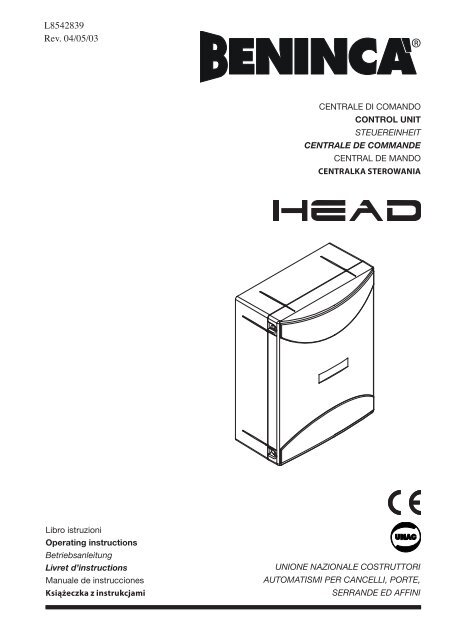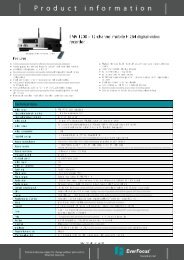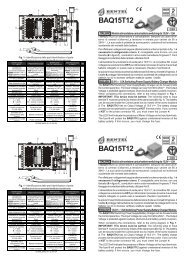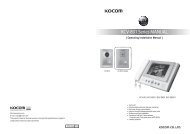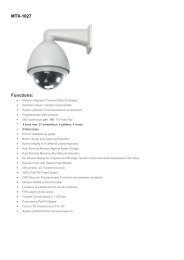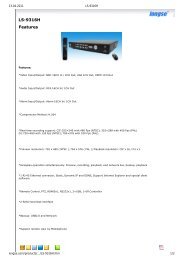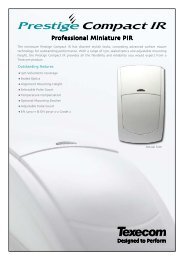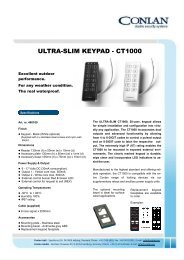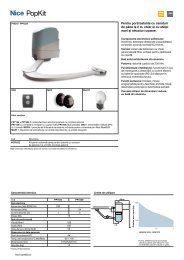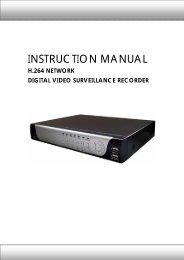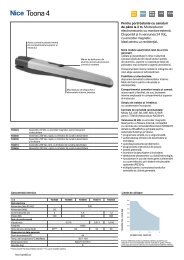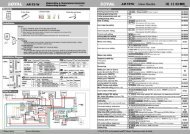Centrala pentru automatizare porti Beninca HEAD - GTO Security ...
Centrala pentru automatizare porti Beninca HEAD - GTO Security ...
Centrala pentru automatizare porti Beninca HEAD - GTO Security ...
You also want an ePaper? Increase the reach of your titles
YUMPU automatically turns print PDFs into web optimized ePapers that Google loves.
L8542839<br />
Rev. 04/05/03<br />
CENTRALE DI COMANDO<br />
CONTROL UNIT<br />
STEUEREINHEIT<br />
CENTRALE DE COMMANDE<br />
CENTRAL DE MANDO<br />
CENTRALKA STEROWANIA<br />
Libro istruzioni<br />
Operating instructions<br />
Betriebsanleitung<br />
Livret d’instructions<br />
Manuale de instrucciones<br />
Książeczka z instrukcjami<br />
UNIONE NAZIONALE COSTRUTTORI<br />
AUTOMATISMI PER CANCELLI, PORTE,<br />
SERRANDE ED AFFINI
3
<strong>HEAD</strong> Control Unit<br />
The electronic control unit <strong>HEAD</strong> can be used to control 2 motors with a power not exceeding 350+350W.<br />
GENERAL WARNINGS<br />
a) The wire connections and the operating logic should be in compliance with regulations in force.<br />
b) The cables featuring different voltage should be physically detached, or adequately insulated by an additional<br />
insulation of at least 1 mm.<br />
c) The cables should be further fastened in proximity to the terminals.<br />
d) Check all connections before powering the unit.<br />
e) Check that settings of the Dip-switches are the required ones.<br />
f) The N.C. inputs which are not in use should be short-circuited.<br />
Terminal No. Function Description<br />
INPUT/OUTPUT FUNCTIONS<br />
1-2 Power supply Input, 230Vac 50Hz (1-Phase/2-Neutral)<br />
3-4 Flashing light Output, flashing light connection, 230Vac 40W max.<br />
5-6-7 Motor 2 Connection to motor 2 : (5-move/6-Com/7-move)<br />
8-9-10 Motor 1 Connection to motor 1 : (8-move/9-Com/10-move) – delayed in closing<br />
phase. If only one motor is used, connect Motor 1 output and adjust<br />
TRAC to the minimum value.<br />
11-12 24 Vac Output, accessories power supply 24Vac/1A max.<br />
13-14 Electric lock Electric lock connection, 12Vac/0,5A max.<br />
11-15 SCA Open gate indicator light connection, 24 Vac/3W max.<br />
16-17 RX 2ch. Output, second radio channel. N.O. contact, voltage free.<br />
It is enabled with both fixed receiver and expandable two-channel receiver<br />
18-19 Aerial Aerial connection, radio receiver card and incorporated radio module<br />
(18-screen/19-signal).<br />
20 Pedestrian Input, N.O. pedestrian push-button<br />
Activation is carried out on motor M1 (8-9-10)<br />
21 Step-by-Step Input, N.O. step-by-step push-button<br />
22 STOP Input, N.C. STOP push-button<br />
23 PHOT Input, safety devices connection, N.C. terminal (e.g. photocells)<br />
24 +V Common to all control inputs.<br />
25-26-27 0-24-12 Connection to transformer secondary winding<br />
28-29-30 L1-T1-N1 Connection to transformer primary winding<br />
J3 Radio receiver Connector for two-channel radio receiver (optional)<br />
To check connections:<br />
1) Cut-off power supply.<br />
2) Manually release the wings, move them to approx. half-stroke and lock them again.<br />
3) Reset power supply.<br />
4) Send a step-by-step control signal by pressing the button or the remote control key.<br />
5) The wings should start an opening movement. If this is not the case, invert the movement wires of the motor.<br />
(8/10 for motor M1, and 5/7 for motor M2).<br />
6) Adjust Time, Operating Logic and Motor Power.<br />
To adjust the motor power<br />
WARNING! This adjustment affects the safety of the automatic system.<br />
Check that the thrust applied onto the wing complies with regulations in force.<br />
A Faston (T1) connector is provided on the power supply transformer which allows the power adjustment of the<br />
motors on 4 different levels. By moving the Faston (T1) to 120, power is at minimum, by moving it to 230, power<br />
is at maximum.<br />
Position 230 can be used only with motors complete with adjustable mechanical clutch.<br />
7
In any case, check compliance with regulations in force.<br />
Functions of Trimmers<br />
TCA The automatic closure time can be adjusted with this trimmer. Check Dip-switch N°2= On.<br />
This function can be adjusted between 1 s minimum and 125 s maximum<br />
TL The maximum time of the opening and closing phases can be adjusted with this trimmer.<br />
Time should be preset approx. 4 sec. longer than the actual stroke time of the automatic system.<br />
Adjustment ranges from 5 s minimum to 130 s maximum<br />
Note: In the event of partial opening/closing, the control unit calculates the remaining time to<br />
complete the operation in order to avert useless overheating of the motor.<br />
TRAC It allows to adjust the delay time with which motor 1 starts closing with respect to motor 2.<br />
Adjustment range from 3 s minimum to 30 s maximum. During opening, the out of phase time of the<br />
motors is 2 seconds.<br />
Dip-Switch functions<br />
DIP 1 “P.P. Mod” The operating mode of ”Pulsante P.P.” (Step-by-step push button) and of the transmitter<br />
is selected.<br />
Off: operation : APRE > STOP > CHIUDE > STOP ><br />
On: operation: APRE > CHIUDE > APRE ><br />
DIP 2 “C.A.” Automatic closure is enabled or disabled.<br />
Off: disabled automatic closure<br />
On: enabled automatic closure<br />
DIP 3 “Cond.” The multi-flat function is enabled or disabled.<br />
Off: disabled multi-flat function.<br />
On: enabled multi-flat function. The P.P. (Step-by-step) impulse or the impulse of the<br />
transmitter have no effect in the opening phase.<br />
DIP 4 “Prelam.” Forewarning flashing light enabled or disabled<br />
Off: disabled forewarning flashing light<br />
On: enabled forewarning flashing light. The flashing light is activated 3 s before the motor<br />
starts.<br />
Note: After modifying the setting of trimmers and Dip-Switches, switch off and power the unit again.<br />
Configuration of the built-in receiver<br />
The control unit is complete with an incorporated radio receiver for both fixed-code and variable code radio<br />
controls, at 433.92MHz frequency.<br />
To use a radio control, its code should be copied first. The memorization procedure is shown here under. The<br />
device is able to store up to 14 different codes in memory.<br />
Memorization of a new transmitter with activation of the P.P. (step-by-step) function<br />
- Press PGM button once for 2 seconds, the D4 LED starts flashing rapidly.<br />
- Within 10s, press the transmitter push-button which should be stored in memory with P.P. function.<br />
Memorization of a new transmitter with activation of 2nd radio channel output (Terminals 16-17)<br />
- Press button PGM twice, each time for at least 2 seconds, the D4 LED switches on with fixed light.<br />
- Within 10s, press the transmitter push-button which should be stored in memory with 2nd radio channel<br />
function.<br />
To exit the programming mode, wait for 10s or press the PGM button for 2 seconds, the D4 LED flashes regularly<br />
again.<br />
To delete the control unit codes from memory<br />
- Cut-off power supply to the control unit<br />
- Reset power supply by keeping the PGM button pressed for 5 seconds; the D4 LED switches on with fixed<br />
light and then off when deletion is completed.<br />
- Release the PGM button, memory is deleted and the D4 LED starts flashing regularly again.<br />
NOTE: If the D4 LED switches on with two long flashes and then switches off, when entering the transmitter<br />
codes memorization mode, this means that the receiver is full and no other transmitter code can be stored in<br />
memory.<br />
8
LED diagnostics<br />
The control unit is complete with a series of self-diagnostics LED’s which allow checking of all functions:<br />
LED PD It switches on when the pedestrian push-button is activated<br />
LED PP It switches on when the step-by-stop push-button is activated<br />
LED SP It switches off when the STOP push-button is activated<br />
LED PH It switches off when photocells are not aligned or when obstacles are present<br />
LED D4 Programming of radio-controls. It is usually flashing to indicate the regular operation of the control<br />
unit.<br />
Advanced programming<br />
The advanced programming permits to activate some special functions:<br />
1) Photocells input, activated in both opening and closure on terminal 22.<br />
In swing gates, it might be useful to connect the inside photocells (columns) to this terminal and connect the<br />
outside photocells to input PHOT (terminal 23).<br />
In this way, the gate opening movement is impaired if the inside photocells detect the presence of an obstacle.<br />
The outside photocells remain, as usual, activated only in the closing phase.<br />
2) Rapid closure activation. If the photocells are passed by, this function carries out the gate closure after 3s,<br />
without considering the TCA time. The 2 “CA” Dip-Switch should be positioned to ON.<br />
3) Radio receiver enabled only to variable code transmitters. Any possible programmable code transmitters<br />
which have been previously installed remain stored in the receiver memory but are deactivated.<br />
To activate the advanced functions, proceed as follows:<br />
1 - Press the PGM button for 2 seconds and then release it - the D4 LED light flashes rapidly<br />
2 - Press the PGM button for 2 seconds and then release it - the D4 LED light stays switched on<br />
3 - Press the PGM button and keep it pressed - the D4 LED flashes three times and then a pause<br />
follows<br />
4 - Within 30s, keeping the PGM button pressed, carry out the enabling of the special functions by using the<br />
following Dip-Switches :<br />
DIP 1 “STOP/PHOT Opn/Cls”. The operating mode of input 22 is selected with this Dip-Switch.<br />
On: Terminal 22: Input, photocell activated in both opening and closure<br />
Off: Terminal 22: Input, STOP push-button<br />
DIP 2 ”Rapid closure” . This automatic closure is enabled or disabled by this Dip-Switch.<br />
On: Enabled rapid closure<br />
Off: Disabled rapid closure<br />
DIP 3 “Radio”. This enables or disables the programmable code transmitters.<br />
On: Radio receiver, enabled exclusively for variable code transmitters.<br />
Off: Receiver, enabled for variable code and programmable code transmitters.<br />
At end of 30 seconds, the D4 LED stays on, the control unit reads out the position of Dip-Switches 1/2/3 and<br />
enables or disables the advanced functions.<br />
5 - Release the PGM button - Move the Dip-Switches to the original position.<br />
6 - Cut-off mains power supply and power the unit again.<br />
9
LED diagnostics<br />
The control unit is complete with a series of self-diagnostics LED’s which allow checking of all functions:<br />
LED PD It switches on when the pedestrian push-button is activated<br />
LED PP It switches on when the step-by-stop push-button is activated<br />
LED SP It switches off when the STOP push-button is activated<br />
LED PH It switches off when photocells are not aligned or when obstacles are present<br />
LED D4 Programming of radio-controls. It is usually flashing to indicate the regular operation of the control<br />
unit.<br />
Advanced programming<br />
The advanced programming permits to activate some special functions:<br />
1) Photocells input, activated in both opening and closure on terminal 22.<br />
In swing gates, it might be useful to connect the inside photocells (columns) to this terminal and connect the<br />
outside photocells to input PHOT (terminal 23).<br />
In this way, the gate opening movement is impaired if the inside photocells detect the presence of an obstacle.<br />
The outside photocells remain, as usual, activated only in the closing phase.<br />
2) Rapid closure activation. If the photocells are passed by, this function carries out the gate closure after 3s,<br />
without considering the TCA time. The 2 “CA” Dip-Switch should be positioned to ON.<br />
3) Radio receiver enabled only to variable code transmitters. Any possible programmable code transmitters<br />
which have been previously installed remain stored in the receiver memory but are deactivated.<br />
To activate the advanced functions, proceed as follows:<br />
1 - Press the PGM button for 2 seconds and then release it - the D4 LED light flashes rapidly<br />
2 - Press the PGM button for 2 seconds and then release it - the D4 LED light stays switched on<br />
3 - Press the PGM button and keep it pressed - the D4 LED flashes three times and then a pause<br />
follows<br />
4 - Within 30s, keeping the PGM button pressed, carry out the enabling of the special functions by using the<br />
following Dip-Switches :<br />
DIP 1 “STOP/PHOT Opn/Cls”. The operating mode of input 22 is selected with this Dip-Switch.<br />
On: Terminal 22: Input, photocell activated in both opening and closure<br />
Off: Terminal 22: Input, STOP push-button<br />
DIP 2 ”Rapid closure” . This automatic closure is enabled or disabled by this Dip-Switch.<br />
On: Enabled rapid closure<br />
Off: Disabled rapid closure<br />
DIP 3 “Radio”. This enables or disables the programmable code transmitters.<br />
On: Radio receiver, enabled exclusively for variable code transmitters.<br />
Off: Receiver, enabled for variable code and programmable code transmitters.<br />
At end of 30 seconds, the D4 LED stays on, the control unit reads out the position of Dip-Switches 1/2/3 and<br />
enables or disables the advanced functions.<br />
5 - Release the PGM button - Move the Dip-Switches to the original position.<br />
6 - Cut-off mains power supply and power the unit again.<br />
9


